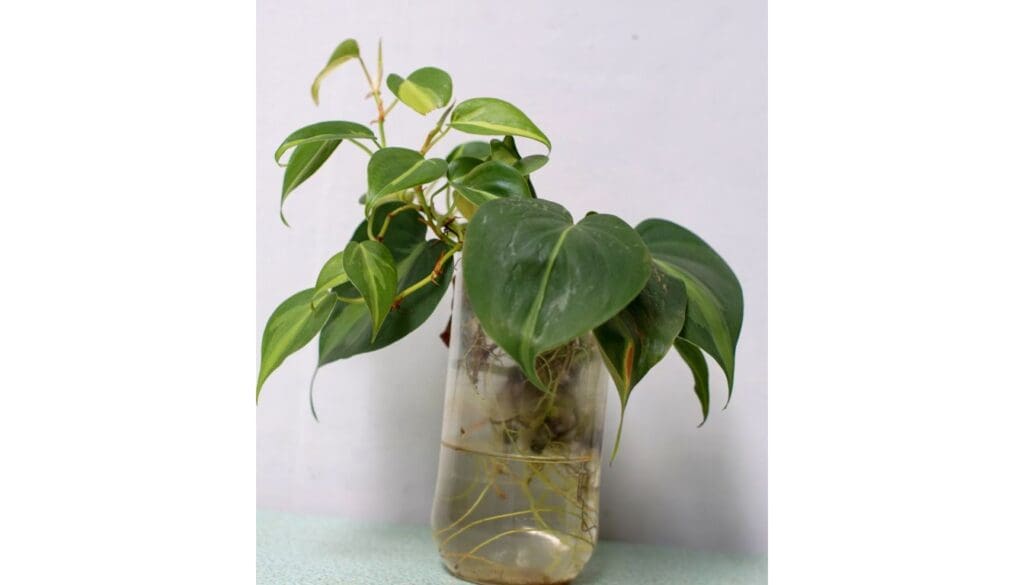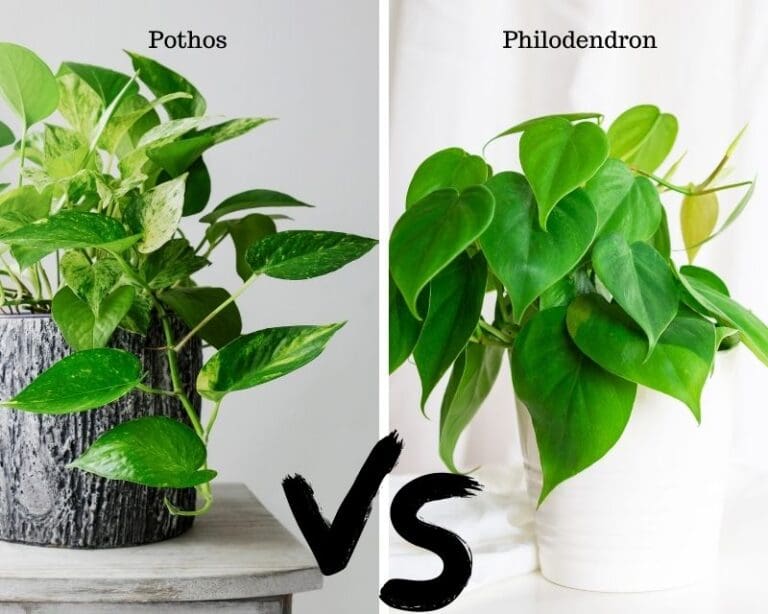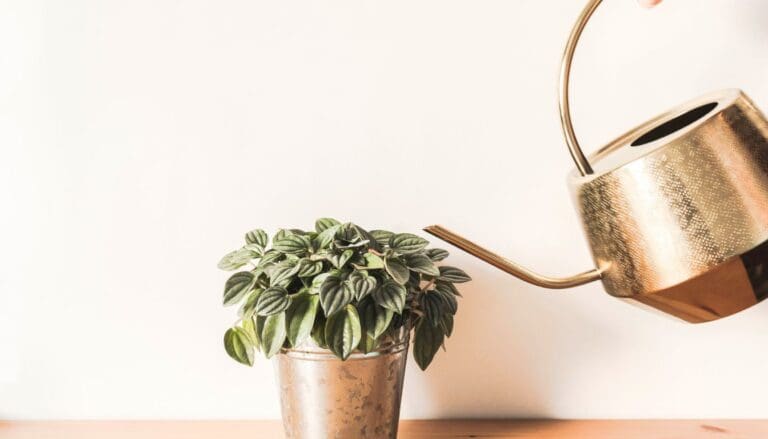Can Philodendron Grow In Water? (How To+Care)
Philodendrons are low-maintenance tropical plants that are widely loved in the houseplant community. These plants are found in non-climbing and vining varieties. Did you know that you can grow your philodendron in water? Yes, vining philodendrons such as the Heart Leaf philodendron can grow in water.
Not all species of philodendrons can grow in water, but the popular Heart Leaf philodendron and Velvet Leaf Vine philodendron can be grown in water. Clip a cutting from the node and put it in a jar of water. You just need to keep changing the water every few days, and your plant will grow.
If you already have a philodendron, you can take a healthy cutting from the existing plant, propagate it in water, and leave it there even after it grows roots. Growing a philodendron in water can save you a lot of hassle, and let’s not forget how it can liven up the space where you place it.
If you wish to grow your philodendron in water, read this article as we will discuss how you can grow it in water and how you can take care of it.

Please note: Simplify Plants is reader-supported. Some links in the post are affiliate links and I get a commission from purchases made through links in the post.
How to grow philodendron in water?
You can grow your vining philodendron in water, which will grow as bushy as it usually would when grown in soil.
If you want to plant the philodendron in the soil anytime, you can easily take it from the water and plant it inside the soil. It will grow equally well in the soil after growing in water for a while.
Let’s check out the ingredients we will require.
A glass jar: It is best to get a glass jar as you will be able to check the root growth and understand if it is time to change the water by looking at the jar.
However, you can get any vase of your choice.
Water: Of course, you’ll need water as the philodendron will grow and absorb all the required nutrients from the water. Make sure to use good quality water that doesn’t contain harmful chemicals for the plant.
You must change the water frequently so that the philodendron remains healthy and doesn’t run out of nutrients.
Garden shears: You must get a healthy cutting from your existing philodendron plant. Garden shears or pruners will help you to make a clean cut. A clean-cut is essential as blunt cuts will prove to be damaging for the parent plant.
Make sure to sterilize the gardening shears before and after cutting the vine.
Pole: When you are growing and cutting the philodendron in the water, you might need to get any pole or hooks on the wall that can help the vine climb and remain upright; otherwise, the plant can easily fall off due to lack of support.
We will now discuss the way to grow the philodendron plant in water.
Also read: 10 Tips For Growing Philodendron (Most People Miss No.6)
Take a healthy cutting

The quality of the cutting you take will determine the growth and health of the philodendron that grows in the water.
Before taking the cutting, remember these points:
- It should be healthy: You must cut from a healthy philodendron. It is essential to take a healthy cut as it will have the slightest chance of developing diseases or getting infected with pests. A healthy cutting will also grow well and be bushy.
If your existing philodendron is not doing well, don’t worry. Try to take care of the problem and let the plant recover. Find the healthiest stem and take a cutting from that stem. - Do not select a young stem: Young stems may not be hardy enough to survive in the water, so you should avoid taking cutting from a young stem. On the other hand, old stems or vines can take a long time to grow. So, try to find a stem that is neither too young nor too old.
- The cutting should have a node: You must make the cut below a leaf node that looks like a bump on the stem. This is important because the roots will come out from the node.
- Make a clean cut: If you don’t make a clean cut, you won’t be able to grow a healthy philodendron. A clean cut will grow healthy roots fast. But if the cutting is poor, rot growth will take much time. You might notice diseases like root rot later on in the plant. Or the plant might not survive at all.
Place the cutting in water.
After taking a clean and healthy cut from your philodendron plant, you must place it in water inside the jar. Make sure that the water is non-chlorinated.
The leaf node should stay inside the water, and use the pole or hooks on the wall to keep your philodendron upright.
You will start seeing root growth within one or two weeks. And soon, the plant will show new growth and become bushy if you take good care of it.
How do you take care of a philodendron in water?
Whether your philodendron will thrive in water or not depends on whether you take proper care of the plant.
It is effortless to grow a philodendron in water, and it will not demand a lot of attention. But you must provide the proper living conditions to keep the plant healthy.
Let’s check the requirements of the philodendron growing in water.
Light

Philodendrons prefer bright indirect light, although they can grow in low light. The vines will bend towards the light and grow in that direction. If you want even growth, you must rotate the plant at regular intervals.
Keep the plant far from direct sunlight, as the direct sun can scorch the philodendron leaves. You will start noticing yellow leaves and discoloration due to sun exposure. The plant can even die if it is exposed to direct sunlight for an extended period.
Also read: What Kind Of Light Does A Philodendron Need? (Light Requirements)
Temperature
Philodendrons come from a tropical climate where they are used to warm temperatures. Try to maintain the temperature levels between 65-80°F for a thriving philodendron.
There can be slight variations that the philodendron can tolerate. If the temperature drops down to 50°F in winter or rises to 90°F in summer, you won’t lose your philodendron because of that.
If the temperature is high, you must change the water of the jar more often as more water will evaporate due to the excess heat.
However, try to protect your philodendron from low temperatures that can slow plant growth.
Humidity

Philodendrons prefer high humidity, and all you need to do is find ways to increase the humidity for the philodendron so that it doesn’t face any problems while growing.
Planting the philodendron in water helps to increase the humidity to an extent. However, you might need to mist the plant sometimes.
The right amount of humidity will result in healthy and shiny leaves on the plant.
Also read: Do Philodendrons Like To Be Misted? (+Ways To Boost Humidity)
Water quality
Do not use regular tap water containing chlorine or other minerals that might restrict the plant’s growth.
The best choice would be to use distilled or rainwater as these don’t contain harsh chemicals that might affect your philodendron.
Since the philodendron is growing in water, maintaining the quality becomes more critical than ever.
Poor-quality water can shock the plant, so you must avoid that.
Also read: How Much Water Does A Philodendron Need? (Water Requirement+How Often)
Fertilization
When the philodendron is growing in water, it will absorb all the required nutrients from the water, giving you another reason to use good quality water.
You can use a liquid fertilizer suitable for adding nutrients to the water for the plants that grow in water. You can add a fertilizer drop to the water every time you change it.
Ensure not to overdo it, as over-fertilization can burn the roots of the philodendron.
Also read: What Kind Of Fertilizer For Philodendron? (Best Fertilizer+Fertilizer Ratio)
Pruning
Pruning frequently will help the philodendron to remain in shape and allow you to keep it your desired size.
You can use the pruned stems or vines for propagation.
Philodendrons grow yearly, so you can prune the plant whenever possible. However, don’t prune too much at once, as that can stress the plant.
Repotting

You don’t need to repot the philodendron growing in water because it’s rare for the roots to outgrow the container.
You might need to repot if you want to change the container or move the plant to soil. Otherwise, you can keep the philodendron in the same jar or container.
You just need to change the water once a week and prune the philodendron to keep the growth in control, and your philodendron will not require any repotting.
However, if the jar is too small, the roots can become root-bound, and you must then move the plant to a larger jar or vase.
You might notice aerial roots when your philodendron is growing in water. You can remove these roots when you decide to change the water.
Also read: When Should I Repot My Philodendron?
FAQ
How long does it take for philodendrons to grow roots in water?
It will be easy for you to track the root growth when the philodendron is growing in water. You will see root growth in about two or three weeks. New leaves will soon follow.
Why is my philodendron not growing roots in water?
Your philodendron may not be growing roots in water due to various reasons. Let’s look at some:
- You chose a weak and unhealthy stem or vine for the cutting.
- You propagated at the wrong time.
- The cutting was too young to grow roots.
- The cutting is not getting enough humidity.
- The water quality is poor.
- The temperature is not ideal for the cutting to grow roots.
- You did not make a clean cut on the stem that you are propagating.
- You did not include a leaf node while taking the cutting.
- Low light will not allow the roots to grow.
Try to find out the problem and fix it so that your philodendron can grow roots in water.
Ref: Wikipedia.
Recommended Garden Supplies
| Product Image | Our Recommended Gardening Supplies | Check Offers! |
|---|---|---|
Top Top
Top
Top
Top
Top
Top
Top
Top | rePotme Houseplant and Tropical Classic Potting Soil Mix | Check Offer On Amazon |
 Top
Top
Top
Top
Top
Top
Top
Top | Espoma Organic Indoor Plant Food | Check Offer On Amazon |
 Top
Top
Top
Top
Top
Top
Top
Top | GooingTop LED Grow Light 6000K Full Spectrum Clip Plant Growing Lamp | Check Offer On Amazon |
 Top
Top
Top
Top
Top
Top
Top
Top | Soil Moisture Meter | Check Offer On Amazon |
 Top
Top
Top
Top
Top
Top
Top
Top | Govee Hygrometer Thermometer, Bluetooth Enabled! | Check Offer On Amazon |
 Top
Top | LEVOIT Humidifiers for Large Room(Best For Plants) | Check Offer On Amazon |
 Top
Top
Top
Top
Top
Top
Top
Top | Upgraded DIY Automatic Drip Irrigation Kit, 15 Potted Houseplants Support | Check Offer On Amazon |
 Top
Top
Top
Top
Top
Top
Top
Top | Stainless Steel Heavy Duty Gardening Tool Set | Check Offer On Amazon |
 Top
Top
Top
Top
Top
Top
Top
Top | Bonide Insecticidal Soap | Check Offer On Amazon |
 Top
Top
Top
Top
Top
Top
Top
Top | Bonide 32 oz Spray Neem Oil for Organic Gardening | Check Offer On Amazon |
 Top
Top
Top
Top
Top
Top
Top
Top | Garden Safe Fungicide | Check Offer On Amazon |






